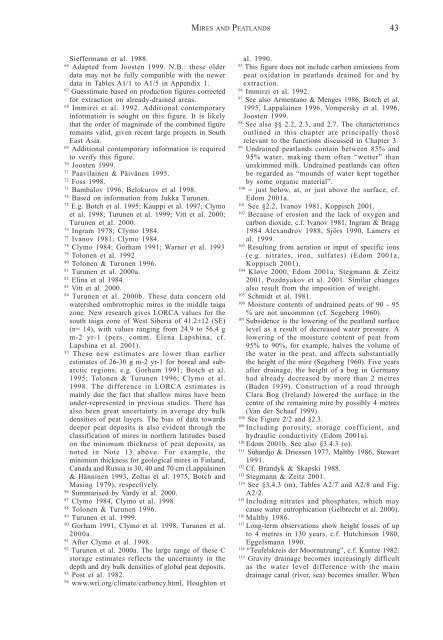wise use of mires and peatlands - Peatland Ecology Research Group
wise use of mires and peatlands - Peatland Ecology Research Group
wise use of mires and peatlands - Peatland Ecology Research Group
Create successful ePaper yourself
Turn your PDF publications into a flip-book with our unique Google optimized e-Paper software.
MIRES AND PEATLANDS43Sieffermann et al. 1988.66Adapted from Joosten 1999. N.B.: these olderdata may not be fully compatible with the newerdata in Tables A1/1 to A1/5 in Appendix 1.67Guesstimate based on production figures correctedfor extraction on already-drained areas.68Immirzi et al. 1992. Additional contemporaryinformation is sought on this figure. It is likelythat the order <strong>of</strong> magnitude <strong>of</strong> the combined figureremains valid, given recent large projects in SouthEast Asia.69Additional contemporary information is requiredto verify this figure.70Joosten 1999.71Paavilainen & Päivänen 1995.72Foss 1998.73Bambalov 1996, Belokurov et al 1998.74Based on information from Jukka Turunen.75E.g. Botch et al. 1995; Kauppi et al. 1997; Clymoet al. 1998; Turunen et al. 1999; Vitt et al. 2000;Turunen et al. 2000.76Ingram 1978; Clymo 1984.77Ivanov 1981; Clymo 1984.78Clymo 1984; Gorham 1991; Warner et al. 199379Tolonen et al. 199280Tolonen & Turunen 1996.81Turunen et al. 2000a.82Elina et al 1984.83Vitt et al. 2000.84Turunen et al. 2000b. These data concern oldwatershed ombrotrophic <strong>mires</strong> in the middle taigazone. New research gives LORCA values for thesouth taiga zone <strong>of</strong> West Siberia <strong>of</strong> 41.2±12 (SE)(n= 14), with values ranging from 24.9 to 56.4 gm-2 yr-1 (pers. comm. Elena Lapshina, cf.Lapshina et al. 2001).85These new estimates are lower than earlierestimates <strong>of</strong> 26-30 g m-2 yr-1 for boreal <strong>and</strong> subarcticregions, e.g. Gorham 1991; Botch et al.1995; Tolonen & Turunen 1996; Clymo et al.1998. The difference in LORCA estimates ismainly due the fact that shallow <strong>mires</strong> have beenunder-represented in previous studies. There hasalso been great uncertainty in average dry bulkdensities <strong>of</strong> peat layers. The bias <strong>of</strong> data towardsdeeper peat deposits is also evident through theclassification <strong>of</strong> <strong>mires</strong> in northern latitudes basedon the minimum thickness <strong>of</strong> peat deposits, asnoted in Note 13 above. For example, theminimum thickness for geological <strong>mires</strong> in Finl<strong>and</strong>,Canada <strong>and</strong> Russia is 30, 40 <strong>and</strong> 70 cm (Lappalainen& Hänninen 1993, Zoltai et al. 1975, Botch <strong>and</strong>Masing 1979), respectively.86Summarised by Vardy et al. 2000.87Clymo 1984, Clymo et al. 1998.88Tolonen & Turunen 1996.89Turunen et al. 1999.90Gorham 1991, Clymo et al. 1998, Turunen et al.2000a.91After Clymo et al. 1998.92Turunen et al. 2000a. The large range <strong>of</strong> these Cstorage estimates reflects the uncertainty in thedepth <strong>and</strong> dry bulk densities <strong>of</strong> global peat deposits.93Post et al. 1982.94www.wri.org/climate/carboncy.html, Houghton etal. 1990.95This figure does not include carbon emissions frompeat oxidation in peatl<strong>and</strong>s drained for <strong>and</strong> byextraction.96Immirzi et al. 1992.97See also Armentano & Menges 1986, Botch et al.1995, Lappalainen 1996, Vompersky et al. 1996,Joosten 1999.98See also §§ 2.2, 2.3, <strong>and</strong> 2.7. The characteristicsoutlined in this chapter are principally thoserelevant to the functions discussed in Chapter 3.99Undrained peatl<strong>and</strong>s contain between 85% <strong>and</strong>95% water, making them <strong>of</strong>ten “wetter” thanunskimmed milk. Undrained peatl<strong>and</strong>s can <strong>of</strong>tenbe regarded as “mounds <strong>of</strong> water kept togetherby some organic material”.100= just below, at, or just above the surface, cf.Edom 2001a.101See §2.2, Ivanov 1981, Koppisch 2001.102Beca<strong>use</strong> <strong>of</strong> erosion <strong>and</strong> the lack <strong>of</strong> oxygen <strong>and</strong>carbon dioxide, c.f. Ivanov 1981, Ingram & Bragg1984 Alex<strong>and</strong>rov 1988, Sjörs 1990, Lamers etal. 1999.103Resulting from aeration or input <strong>of</strong> specific ions(e.g. nitrates, iron, sulfates) (Edom 2001a,Koppisch 2001).104Kløve 2000, Edom 2001a, Stegmann & Zeitz2001, Pozdnyakov et al. 2001. Similar changesalso result from the imposition <strong>of</strong> weight.105Schmidt et al. 1981.106Moisture contents <strong>of</strong> undrained peats <strong>of</strong> 90 - 95% are not uncommon (cf. Segeberg 1960).107Subsidence is the lowering <strong>of</strong> the peatl<strong>and</strong> surfacelevel as a result <strong>of</strong> decreased water pressure. Alowering <strong>of</strong> the moisture content <strong>of</strong> peat from95% to 90%, for example, halves the volume <strong>of</strong>the water in the peat, <strong>and</strong> affects substantiallythe height <strong>of</strong> the mire (Segeberg 1960). Five yearsafter drainage, the height <strong>of</strong> a bog in Germanyhad already decreased by more than 2 metres(Baden 1939). Construction <strong>of</strong> a road throughClara Bog (Irel<strong>and</strong>) lowered the surface in thecentre <strong>of</strong> the remaining mire by possibly 4 metres(Van der Schaaf 1999).108See Figure 2/2 <strong>and</strong> §2.3.109Including porosity, storage coefficient, <strong>and</strong>hydraulic conductivity (Edom 2001a).110Edom 2001b. See also §3.4.3 (o).111Suhardjo & Driessen 1977, Maltby 1986, Stewart1991.112Cf. Br<strong>and</strong>yk & Skapski 1988.113Stegmann & Zeitz 2001.114See §3.4.3 (m), Tables A2/7 <strong>and</strong> A2/8 <strong>and</strong> Fig.A2/2.115Including nitrates <strong>and</strong> phosphates, which mayca<strong>use</strong> water eutrophication (Gelbrecht et al. 2000).116Maltby 1986.117Long-term observations show height losses <strong>of</strong> upto 4 metres in 130 years, c.f. Hutchinson 1980,Eggelsmann 1990.118“Teufelskreis der Moornutzung”, c.f. Kuntze 1982.119Gravity drainage becomes increasingly difficultas the water level difference with the maindrainage canal (river, sea) becomes smaller. When
















